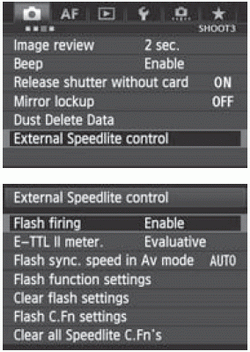Setting the Flash
With an EX-series Speedlite having compatible flash function settings, you can use the camera’s menu screen to set the Speedlite’s functions and Custom Functions. Attach the Speedlite to the camera and turn on the Speedlite.
For details on the Speedlite’s functions, refer to the Speedlite’s instruction manual.
 | 1 Select [External Speedlite control]. Under the  tab, select [External Speedlite control], then press < tab, select [External Speedlite control], then press < >. >. The external Speedlite control screen will appear.
2 Select the desired item. |
| Flash Firing 
| - To enable flash photography, set [To enable only the AF-assist beam to be emitted, set [Disable].
|
| E-TTL II Meter 
| - For normal flash exposures, set it to [If [Average] is set, the flash exposure will be averaged for the entire metered scene. Flash exposure compensation may be necessary. This setting is for advanced users.
|
| Flash Sync Speed in Av Mode 
| You can set the flash-sync speed for flash photography in the aperture-priority AE (Av) mode The flash sync speed is set automatically within a range of 1/250 sec. to 30 sec. to suit the scene’s brightness. High-speed sync is also possible. Prevents a slow shutter speed from being set in low-light conditions. It is effective for preventing subject blur and camera shake. However, while the subject will be properly exposed with the flash, the background may come out dark. The flash-sync speed is fixed at 1/250 sec. This more effectively prevents subject blur and camera shake than with [1/250-1/60 sec. auto]. However, in low light, the subject’s background will come out darker than with [1/250-1/60 sec. auto]. |
If [1/250-1/60 sec. auto] or [1/250 sec. (fixed)] is set, high-speed sync is not possible in the <f> mode.